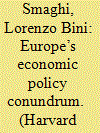|
|
|
Sort Order |
|
|
|
Items / Page
|
|
|
|
|
|
|
| Srl | Item |
| 1 |
ID:
110301


|
|
|
|
|
| Publication |
2012.
|
| Summary/Abstract |
The project of European integration is experiencing its gravest political crisis to date. Ongoing debate about how to restore the financial stability of the eurozone has exposed deep rifts within the EU, calling into question the solidarity that is the hallmark of political union. At stake is the survival not just of the euro, but the EU itself.
The EU's debt crisis poses a particularly potent threat to the project of European integration because it is both a consequence and a cause of a more serious malady: the renationalisation of European politics. Confronted with the powerful intrusions of both European integration and globalisation, electorates in EU member states have for the better part of a decade staged a mounting revolt against Brussels and its supranational brand of governance. Unwanted immigration, growing inequality, fraying welfare states, stagnant wages, bailout and austerity packages - these developments have produced a wave of popular discontent, which is in turn exacting a heavy toll on the EU as angry voters press for the repatriation of political control and the restoration of national autonomy.
|
|
|
|
|
|
|
|
|
|
|
|
|
|
|
|
| 2 |
ID:
144850


|
|
|
|
|
| Summary/Abstract |
Since the global financial crisis broke out in 2008, China's nonfinancial corporate debt has been rising steadily and rapidly, posing serious threat to China's financial stability. China's rising corporate debt is mainly attributable to three factors: worsening capital efficiency, worsening corporate profitability and high funding costs. Based on a dynamic recursive model developed in the paper, we simulate the trajectories of China's corporate debt-to-GDP ratio, and find that if China fails to reverse the current trends in capital efficiency, corporate profitability and financing costs, China's nonfinancial corporate debt-to-GDP ratio will continue to rise without converging to a limit. Against most economists' intuition, given the current trends of changes in parameters, higher economic growth will not help China to escape the corporate debt trap. On the contrary, it will make China's corporate debt problem even worse. To avert a corporate debt crisis, China needs to speed up the structural reform and change the growth paradigm so as to enhance capital efficiency and firms' profitability, while reducing firms' financing costs.
|
|
|
|
|
|
|
|
|
|
|
|
|
|
|
|
| 3 |
ID:
159042


|
|
|
|
|
| Summary/Abstract |
Analyzing monetary policy in China is not straightforward because the People's Bank of China (PBoC) implements policy by using more than one instrument. In this paper we use a Qual VAR, a conventional VAR system augmented with binary policy announcements, to extract a latent indicator of tightening and easing pressure, respectively, for China. The model acknowledges that policy announcements are endogenous and summarizes policy by a single indicator. The Qual VAR allows us to study the impact of monetary policy in terms of unexpected changes in these latent variables, which we identify using sign restrictions. We show that the transmission of monetary policy impulses to the rest of the economy is similar to the transmission process in advanced economies in terms of both output growth and inflation despite a very different monetary policy framework. We find that bank loans are not sensitive to policy changes, which implies that window guidance is still a necessary policy tool. We also find that the impact of monetary policy shocks is asymmetric in terms of asset prices, that is, the asset price reactions differ in their sensitivity to tightening shocks and easing shocks, respectively. In particular, an easing of monetary conditions boosts stock prices while a tightening shock leaves stock prices unaffected. This shows that monetary policy is not a suitable tool to stabilize asset prices, which raises implications for financial stability and macroprudential policy.
|
|
|
|
|
|
|
|
|
|
|
|
|
|
|
|
| 4 |
ID:
138688


|
|
|
|
|
| Summary/Abstract |
The Eurozone economy is stalling. Growth forecasts have been revised down. Inflation is falling, well below the level consistent with the definition of price stability (two percent). Unemployment remains high. Divergences between the members of the monetary union have not shrank, with northern countries recording large and increasing surpluses in their current accounts, while the deficits in the south have largely been cut through sharp contractions in domestic demand and imports.
|
|
|
|
|
|
|
|
|
|
|
|
|
|
|
|
| 5 |
ID:
127079


|
|
|
|
|
| Publication |
2013.
|
| Summary/Abstract |
With diverse histories and attitudes toward risk-taking, different financial systems have a common aim: ensuring financial stability and efficiency within a geographical region. But differences exist between various financial systems as a result of their evolution and adaptation to their surrounding environment. This paper aims to analyze the incentive and sanction mechanisms of the Islamic mode of banking and the Grameen Bank model of microcredit in Bangladesh, and how they help ensure their financial stability and efficiency. We challenge the conventional explanations of their success. We point out that the informal sanction mechanisms embedded in the two modes of financial intermediation - avoiding non-compliance with Islamic Shari'ah (revealed divine law) in the case of Islamic banking, and kinship-based groupings or gushtis in the case of microcredit - play important roles in lowering the transaction costs of screening and enforcing contracts. We also point out how bank rent opportunity - the promised return from non-participatory financing and a high spread supported through low-cost funds provided by donor agencies and compulsory savings - is captured in each of the two modes, playing a further important role in maintaining their franchise values, given the specificities of the Bangladeshi financial context.
|
|
|
|
|
|
|
|
|
|
|
|
|
|
|
|
| 6 |
ID:
156440


|
|
|
|
|
| Summary/Abstract |
Our paper investigates the relationship between financial stability and mortgage lending. We estimated the effect of the share of mortgage lending by individual banks (together with some control variables) on two measures of financial stability—the bank Z-score and the non-performing loan ratio—for a sample of 1889 banks in 65 advanced and emerging economies for the period 1987–2014 from the Bankscope database. We specifically compared the behavior of banks in Europe and Asia. We find evidence that an increased share of mortgage lending is positive for financial stability, specifically by lowering the probability of default by financial institutions and reducing the non-performing loan ratio, at least in non-crisis periods, for levels of mortgage shares up to 49–68%. For higher levels of mortgage lending shares, the impact on financial stability turns negative. Also, the occurrence of a banking crisis reduces the diversification benefits associated with mortgage lending. Compared with the base sample, Asian banks show greater financial stability during non-crisis periods, but are more negatively affected by a higher mortgage ratio during crisis periods, while European banks show greater financial stability during non-crisis periods, but are less negatively affected during crisis periods. Finally, a higher level of regulatory quality improves both financial stability measures, but the effects of macroprudential measures are found to be mixed.
|
|
|
|
|
|
|
|
|
|
|
|
|
|
|
|
| 7 |
ID:
126796


|
|
|
|
|
| Publication |
2013.
|
| Summary/Abstract |
Much research on conflict and the environment in Africa emphasises the competition for energy resources and valuable minerals as a cause of war. Drawing on current environmental research on conflict in sub-Saharan Africa, this study demonstrates how the lack of adequate wildlife protection generates new sources of instability, notably between poachers and park guards and between local populations and refugees displaced by war. The article offers both an analysis of the important role that wildlife protection can play in the peace-building process after war and an agenda for future research. Effective policies on wildlife can provide a framework for communication between formerly conflicting parties; they can educate the population on the importance of sustainable resource management; and they can promote financial stability. All of these elements are crucial in preventing a renewed cycle of violence.
|
|
|
|
|
|
|
|
|
|
|
|
|
|
|
|
| 8 |
ID:
119655


|
|
|
|
|
| Publication |
2013.
|
| Summary/Abstract |
Chances are that you will never hear a crowd at a protest rally chant, "What do we need? Regulation! When do we need it? Now!"
People want safe food, clean air, and clean water. But in the abstract, regulation is never a popular idea. In a tough economic environment, it might seem like a recipe for disaster. In the United States, businesses large and small have long argued that they are subject to excessive red tape and government oversight, and in the context of a serious recession, that concern has become acute. In light of the country's general enthusiasm for freedom of choice, regulation is particularly vulnerable to political attack.
|
|
|
|
|
|
|
|
|
|
|
|
|
|
|
|
| 9 |
ID:
173201


|
|
|
|
|
| Summary/Abstract |
We verify the potential impact of credit-enhanced monetary policy rule on inflation, GDP and credit dynamics in Turkey (2002Q1—2018Q3), where the Turkish Cental Bank takes into account financial stability in its inflation-targeting strategy. We estimate interest rates from two monetary policy rules (classic and augmented with the exogenous credit-to-GDP gap) with time-varying parameters (TVP) and assess their performance in a TVP-VAR model. The results show that after the global crisis both observed interest rates and those estimated from the Taylor-rule impact inflation and the GDP in a similar way. The central bank’s monetary policy after 2010 was in line with the Taylor rule and took into account cyclical systemic risk with increased strength in the monetary transmission mechanism. Yet, before the crisis, both types of Taylor rules indicate that the bank’s monetary policy should have been more restrictive.
|
|
|
|
|
|
|
|
|
|
|
|
|
|
|
|
|
|
|
|
|